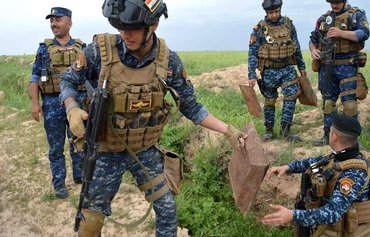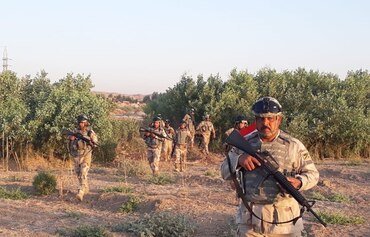As it loses ground on multiple fronts, the "Islamic State of Iraq and Syria" (ISIS) has turned to more secretive tactics to sow panic and assert its presence in the areas no longer under its control, officials tell Diyaruna.
To this end it has been using sleeper cells -- secretive groups that hide among the population until ordered to act -- to carry out suicide attacks.
Apprehending sleeper cells before they can carry out attacks requires the full co-operation of the civilian population, officials said, stressing the importance of heightened public awareness and the need to report suspicious activity.
On April 9th, a local resident alerted the Iraqi forces to a sleeper cell based in a house in eastern Mosul's al-Zuhour neighbourhood.
In response to the tip-off, security forces raided the house -- where they found weapons, explosives and extremist literature -- and arrested two ISIS elements.
A number of similar raids have been carried out in Mosul with the help of local residents, Ninawa provincial council services committee member Hosam Eddin al-Abbar told Diyaruna.
The people of Mosul "suffered greatly when ISIS occupied their areas", he said. They do not wish to see this repeated, he added, which is why they "voluntarily report on terrorist cells".
Acting on information
Inside Mosul, security and intelligence services and local police analyse incoming reports and validate them through their own sources, al-Abbar said.
Once investigations have been completed and court orders are acquired, the wanted individuals are immediately arrested, he said.
Since the beginning of the year, "around 1,200 terrorists that are part of sleeper cells were arrested in liberated areas in Mosul", al-Abbar said, thanks in large part to intelligence information provided by local residents.
Before carrying out premeditated attacks, ISIS elements tasked with secret missions infiltrate into the targeted area and try to integrate themselves into the local population in order to prepare for their attack.
This was the case with a May 7th attack on a Kirkuk military base that security forces were able to repel, confronting five suicide bombers wearing explosive belts who blew themselves up.
According to an initial investigation, local officials said, the attackers were part of an ISIS sleeper cell that had infiltrated the province at an earlier time.
Eliminating sleeper cells
ISIS sleeper cells can be eliminated by expediting the liberation of occupied areas in Kirkuk, and al-Hawija in particular, and by invigorating intelligence work, said Deputy Mayor of Kirkuk Rakan al-Jubury.
"Once these areas are liberated, terrorist leaders lose the ability to direct and activate sleeper cells," he told Diyaruna.
There has been excellent co-operation between Kirkuk residents and the security forces, he said, noting that "not a week goes by without a sleeper cell getting hunted down with direct support from the people".
Displaced residents from ISIS-controlled areas are a rich source of information, he added, and have helped to expose several sleeper cells that have infiltrated the province with the waves of internally displaced persons (IDPs).
On April 18th, local residents led Iraqi intelligence agents to an ISIS hideout in the agricultural area of al-Tarmiya, north of Baghdad, where they apprehended 10 militants with large quantities of explosives in their possession.
Remote, desert areas are "natural hotbeds for terrorist cells and a grave threat", said Anbar provincial council security committee member Rajeh Barakat al-Aifan.
Special forces must be formed to hunt down sleeper cells in outlying areas, he told Diyaruna, adding that sleeper cells are the extremist groups' last resort.
"Our citizens have become well aware of the terrorists’ plans and are offering all the information they have in order to deflect terrorist threats," he added.
Targeting cells in Syria
The Syrian Democratic Forces (SDF) have been focused on eliminating ISIS sleeper cells, which have been infiltrating the convoys transporting IDPs to safer areas in an attempt to recruit young men, SDF officials said.
"To eliminate the threat posed by ISIS sleeper cells, the SDF, in co-operation with the local councils in the liberated areas and agencies affiliated with them, are conducting inspections and constant monitoring to fend off the danger," Ayn Issa refugee camp resident Abdullah Haidar told Diyaruna.
Security has been tightened in areas where there have been waves of displacement, he said, as ISIS has exploited the unrest to establish sleeper cells.
"At the present time, tightened procedures are being particularly applied in handling those fleeing al-Raqa areas," Haidar said. "They are assembled at a camp near Ayn Issa, and all are subjected to security checks to weed out any infiltrators."
Civilians have been made aware of this process, and are co-operating fully with the security forces, he said.
"The residents are fully supportive and comply with the orders issued and measures taken by the security forces, especially in terms of compliance with curfews and staying in the camp until sweep operations are completed," he said.
Dozens of cells uncovered
"ISIS's sleeper cells are absolutely the most lethal of the group’s weapons," said Rebar Nabo, an Asayesh team leader in Qamishli.
All regions in Syria have suffered serious harm from cells spread throughout ISIS-controlled areas and those liberated from the group, he told Diyaruna.
"In the period that followed the liberation of areas in northern Syria, dozens of sleeper cells working for [ISIS] were discovered," he said.
Those cells had various tasks assigned to them, Nabo said.
Some specialised in planting mines and IEDs targeting civilians, while others were tasked with spying for the group by monitoring the military movements of opposing factions.
"The Asayesh special forces arrested a number of sleeper cells that were active in the Tel Hamis area and had planted IEDs to instill fear and apprehension in the hearts of citizens," Nabo said.
These arrests were the result of close surveillance of the area’s residents along with key information provided by local residents, he said.
"Residents of the areas liberated from ISIS report suspicious persons on a daily basis," he added. "Either directly at security centres or to the patrols deployed in the area, or by calling the telephone numbers circulated for this purpose."

![Elements of an 'Islamic State of Iraq and Syria' sleeper cell were arrested in northern Syria. Before carrying out premeditated attacks, ISIS elements infiltrate into the targeted area and try to integrate themselves into the local population in order to prepare for their attack. [Photo courtesy of Rebar Nabo]](/cnmi_am/images/2017/05/19/7919-Syria-ISIS-cell-600_384.jpg)






